|
 |
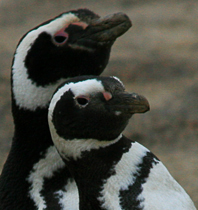 | Magellanic Penguin (Spheniscus magellanicus).  |
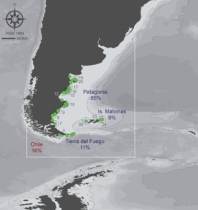 |
Regional Nesting Sites of the Magellanic Penguin (Spheniscus magellanicus).
References. Green dots: colonies and the percentage of the world population that each area represents. Blue text: populations for which the Atlas provides distribution data. Red text: populations for which there are no data. Blue circle: colonies of origin of individuals studied.
| © Valeria Falabella |
 |
Nesting Sites |
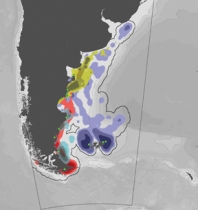 Principal feeding areas Principal feeding areas |
With breeding colonies along the entire Patagonian coastline, Magellanic Penguins makes extensive use of the coastal and shelf waters of the Patagonian Sea.
Data for the colonies of North Patagonia: La Ernestina (6 individuals), Punta Lobería (4 trips studied with geolocators, GLS), Punta Tombo (21 individuals), Cabo Dos Bahías (7 individuals) and Bahía Bustamante (10 individuals studied with GPS). Data for the colonies of South Patagonia: Puerto Deseado (6 individuals), Monte León (6 individuals), San Julián (6 individuals), Cabo Vírgenes (7 trips, GLS); Martillo Island (22 individuals); and the Malvinas Islands: Seal Bay (17 individuals), New Island (5 trips, GLS) and Volunteer Point (13 trips, GLS). All available data between January and December are included.
Dataholders: D. Boersma and E. Frere (La Ernestina, Punta Tombo, Cabo Dos Bahías, Puerto Deseado, Monte León, San Julián); R. Wilson (Punta Lobería, Cabo Vírgenes, New Island, Volunteer Point); F. Quintana and P. Yorio (Bahía Bustamante); K. Pütz, A. Schiavini and A. Raya Rey (Martillo Island); K. Pütz (Seal Bay).
 |  Spring (Patagonia and Malvinas) Spring (Patagonia and Malvinas) |
During the early breeding season, Magellanic Penguins can travel up to 500 km from the colony in shelf waters. When the incubation period starts, one of the pair of adults can spend up to 2 weeks at sea, recovering energy after nesting.
Data on adults of both sexes from colonies 11 in Patagonia and the Malvinas Islands. Northern Patagonia: San Lorenzo (28 trips studied con GLS), Punta Tombo (19 individuals), Punta Lobería (4 trips, GLS) and Cabo Dos Bahías (7 individuals). Southern Patagonia: San Julián (6 individuals), Puerto Deseado (6 individuals), Monte León (6 individuals) and Cabo Vírgenes (7 trips, GLS); and Malvinas Islands: New Island (5 trips, GLS), Volunteer Point (13 trips, GLS) and Seal Bay (12 individuals). Period: October-December (laying and incubation of eggs).
Dataholders: D. Boersma and E. Frere (Punta Tombo, Cabo Dos Bahías, Puerto Deseado, Monte León, San Julián); R. Wilson (San Lorenzo, Punta Lobería, Cabo Vírgenes, New Island, Volunteer Point); K. Pütz (Seal Bay).
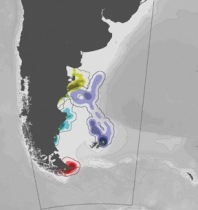 Summer (Patagonia and Malvinas) Summer (Patagonia and Malvinas) |
During the chick-rearing period, Magellanic Penguins drastically restrict their feeding range, mostly visiting areas relatively close to their colonies and, in the case of Patagonia, mainly coastal areas.
Data on adults of both sexes in 9 colonies in Patagonia and the Malvinas Islands. Northern Patagonia: La Ernestina (6 individuals), Punta Tombo (7 individuals), Cabo Dos Bahías (7 individuals), and Bahía Bustamante (10 individuals studied with GPS). Southern Patagonia: San Julián (6 individuals), Puerto Deseado (5 individuals), Monte León (6 individuals); Martillo Island (16 individuals) and Seal Bay in the Malvinas Islands (13 individuals). Period: January-March (chick-rearing).
Dataholders: D. Boersma and E. Frere (La Ernestina, Punta Tombo, Cabo Dos Bahías, Puerto Deseado, Monte León, San Julián); F. Quintana and P. Yorio (Bahía Bustamante); K. Pütz, A. Schiavini and A. Raya Rey (Martillo Island); K. Pütz (Seal Bay).
 | 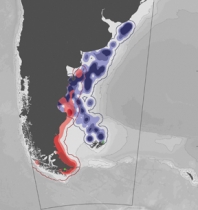 Autumn (Malvinas and Martillo Is.) Autumn (Malvinas and Martillo Is.) |
Satellite tracking of Magellanic Penguins during the migration season reveals that individuals travel as far north as Uruguay and Brazil. The penguins that breed in the far south of Argentina (colony of Martillo Island) migrate in coastal waters of the continental shelf. The penguins that breed in the Malvinas Islands use the shelf and also the edge or the continental slope.
Data on adults of both sexes from Martillo Island (22 individuals) and Seal Bay (Malvinas Islands, 10 individuals). Period: April-June.
Dataholders: K. Pütz, A. Schiavini and A. Raya Rey (Martillo Island); K. Pütz (Seal Bay).
|
 |
Magellanic Penguin
Spheniscus magellanicus
Regional Nesting Sites: Breeding colonies of Magellanic Penguin are located on the Atlantic and Pacific coasts of South America. Around 86% of the world population breeds on the coasts and islands of the Patagonian Sea. Diet: It feeds principally on anchovy, Fuegian sprat, young hake and squid, diving to depths of up to 120 m. World breeding population: Estimaded at 1.3 millon pairs. Conservation Status: Near threatened (IUCN, 2008). Main threats: Oil pollution (accidental spills at sea but also chronic and intentional spills of small volumes of hydrocarbons), the expanding Argentine anchovy fishery (important part of the species's diet), and accidental catch by hake fisheries.

|

